Comparing Human Activity Density and Green Space Supply Using the Baidu Heat Map in Zhengzhou, China
Abstract
:1. Introduction
2. Materials and Methods
2.1. Study Area
2.2. Data Sources and Preprocessing
2.2.1. Classification of Urban Green Space
2.2.2. Human Activity Density Estimation (Baidu Heat Map Layout)
2.3. Methodology
2.3.1. Analytical Framework
2.3.2. HAD Data Conversion and Assignment
2.3.3. Analysis of Human Activity Density Change in Urban Green Space
3. Results of the Analysis
3.1. Spatiotemporal Features of Human Activity Density
3.1.1. Comparison of Human Activity Density at Different Times
3.1.2. Comparison of the Area Used per Hour of Urban Green Space
3.2. Relationship between Human Activity and Different Types of Green Space
- (1)
- For all types of urban green space, the usage rate was square/community park > belt-shaped park > comprehensive park > theme park > green buffer > other green land.
- (2)
- Community parks and belt-shaped parks were the two types of green space that were used most efficiently (63.6% and 43.6% occupied ratio), and they tended to be in short supply.
- (3)
- The square/community parks were generally located close to residential areas, and showed a high occupied ratio from 7:00 to 12:30 and 18:30 to 11:10. The trajectories of different HADs were similar on weekdays and weekends (Figure 9).
- (1)
- Belt-shaped parks had the highest percentage of utilization relative to their availability in the city (43.6%). Due to the flexibility of their shape, they largely compensate for the current shortage of green space and provide an alternative site for the morning and evening rush hours.
- (2)
- Comprehensive parks had a high efficiency and utility rate (36.4%). The frequency of use and the area used on weekends were higher than on weekdays (Figure 10).
- (3)
- There are many theme parks in the central city of Zhengzhou because of the implementation of green-space system planning and decision-making in recent years. However, most of them are far away from residential areas, so their percentage of utilization was only 19.3%.
- (4)
- The percentage of utilization of green buffers and other green lands was low, mainly because they are in the periphery of the city and play a role in ecological protection. However, these areas were visited more on weekends than weekdays.
4. Discussion
5. Conclusions and Policy Recommendations
Author Contributions
Funding
Conflicts of Interest
References
- Xiao, Y.; Wang, Z.; Li, Z.; Tang, Z. An assessment of urban park access in Shanghai–Implications for the social equity in urban China. Landsc. Urban Plan. 2017, 157, 383–393. [Google Scholar] [CrossRef]
- Zhao, R.; Shen, X.; Tian, G.; Guo, Y.; He, R. The influence of landscape characteristics of a park green space on the park cool island effect in Zhengzhou City. Acta Ecol. Sin. 2020, 40, 2886–2894. [Google Scholar]
- Barrico, L.; Azul, A.M.; Morais, M.C.; Coutinho, A.P.; Freitas, H.; Castro, P.; Planning, U. Biodiversity in urban ecosystems: Plants and macromycetes as indicators for conservation planning in the city of Coimbra (Portugal). Landsc. Urban Plan. 2012, 106, 88–102. [Google Scholar] [CrossRef]
- Greco, S.E.; Larsen, E.W. Ecological design of multifunctional open channels for flood control and conservation planning. Landsc. Urban Plan. 2014, 131, 14–26. [Google Scholar] [CrossRef] [Green Version]
- Hladnik, D.; Pirnat, J. Urban forestry—Linking naturalness and amenity: The case of Ljubljana, Slovenia. Urban For. Urban Green. 2011, 10, 105–112. [Google Scholar] [CrossRef]
- Daily, G.; Postel, S.; Bawa, K.; Kaufman, L. Nature’s Services: Societal Dependence on Natural Ecosystems; Island Press: Washington, DC, USA, 1997; pp. 11–17. [Google Scholar]
- Nisbet, E.K.; Zelenski, J.M. Underestimating nearby nature: Affective forecasting errors obscure the happy path to sustainability. Psychol. Sci. 2011, 22, 1101–1106. [Google Scholar] [CrossRef]
- Wolch, J.R.; Byrne, J.; Newell, J.P. Urban green space, public health, and environmental justice: The challenge of making cities just green enough. Landsc. Urban Plan. 2014, 125, 234–244. [Google Scholar] [CrossRef] [Green Version]
- Daniel, T.C.; Muhar, A.; Arnberger, A.; Aznar, O.; Boyd, J.W.; Chan, K.M.; Costanza, R.; Elmqvist, T.; Flint, C.G.; Gobster, P.H.; et al. Contributions of the N.A. of S. Contributions of cultural services to the ecosystem services agenda. Proc. Natl. Acad. Sci. USA 2012, 109, 8812–8819. [Google Scholar] [CrossRef] [Green Version]
- Chiesura, A. The role of urban parks for the sustainable city. Landsc. Urban Plan. 2004, 68, 129–138. [Google Scholar] [CrossRef]
- Thompson, C.W. Linking landscape and health: The recurring theme. Landsc. Urban Plan. 2011, 99, 187–195. [Google Scholar] [CrossRef]
- Mu, B.; Mayer, A.L.; He, R.Z.; Tian, G.H. Land use dynamics and policy implications in Central China: A case study of Zhengzhou. Cities 2016, 58, 39–49. [Google Scholar] [CrossRef]
- Artmann, M.; Kohler, M.; Meinel, G.; Gan, J.; Ioja, I.-C. How smart growth and green infrastructure can mutually support each other—A conceptual framework for compact and green cities. Ecol. Indic. 2019, 96, 10–22. [Google Scholar] [CrossRef]
- Zhengzhou Forestry Bureau. Forest Ecosystem Planning of Zhengzhou, China (2019–2025); Henan Provincial Government: Zhengzhou, China, 2019.
- See, L.; Mooney, P.; Foody, G.; Bastin, L.; Comber, A.; Estima, J.; Fritz, S.; Kerle, N.; Jiang, B.; Laakso, M. Crowdsourcing, citizen science or volunteered geographic information? The current state of crowdsourced geographic information. ISPRS Int. J. Geo. Inf. 2016, 5, 55. [Google Scholar] [CrossRef]
- Kitchin, R. Big Data, new epistemologies and paradigm shifts. Big Data Soc. 2014, 1, 2053951714528481. [Google Scholar] [CrossRef] [Green Version]
- Boyd, D.; Crawford, K. Critical questions for big data: Provocations for a cultural, technological, and scholarly phenomenon. Inf. Commun. Soc. 2012, 15, 662–679. [Google Scholar] [CrossRef]
- Hey, T.; Tansley, S.; Tolle, K. The Fourth Paradigm: Data-Intensive Scientific Discovery; Microsoft Research: Redmond, WA, USA, 2009; Volume 1. [Google Scholar]
- Di Minin, E.; Tenkanen, H.; Toivonen, T. Prospects and challenges for social media data in conservation science. Front. Environ. Sci. 2015, 3, 63. [Google Scholar] [CrossRef] [Green Version]
- Liu, L.; Liu, H.; Wang, Q.; Long, Y. Smart city planning in the era big data: International experience. Urban Plan. Int. 2014, 29, 38–43. [Google Scholar]
- Yan, X.-Y.; Wang, W.-X.; Gao, Z.-Y.; Lai, Y.-C. Universal model of individual and population mobility on diverse spatial scales. Nat. Commun. 2017, 8, 1–9. [Google Scholar] [CrossRef] [Green Version]
- Akiyama, Y. Analysis of Light Intensity Data by the DMSP/OLS Satellite Image Using Existing Spatial Data for Monitoring Human Activity in Japan. In Proceedings of the ISPRS Annals of the Photogrammetry, Remote Sensing and Spatial Information Sciences, I-2, XXII ISPRS Congress, Melbourne, Australia, 25 August–1 September 2012; Volume 25. [Google Scholar]
- Tana; Kwan, M.-P.; Chai, Y. Urban form, car ownership and activity space in inner suburbs: A comparison between Beijing (China) and Chicago (United States). Urban Stud. 2016, 53, 1784–1802. [Google Scholar] [CrossRef]
- Jahromi, K.K.; Zignani, M.; Gaito, S.; Rossi, G.P. Theory Simulating human mobility patterns in urban areas. Simul. Model. Pract. Theory 2016, 62, 137–156. [Google Scholar] [CrossRef]
- Meng, L.I. The Planning Strategies of a 15-Minute Community Life Circle Based on Behaviors of Residents. In Proceedings of the Urban Planning Forum, Dongguan, China, 19–21 October 2017; Volume 233, pp. 111–118. [Google Scholar]
- Li, F. Greenways Planning Methods from Environmental Justice Perspective—An Empirical Study Based on POI Big Data. Chin. Landsc. Archit. 2017, 33, 72–77. [Google Scholar]
- Li, F.; Zhang, F.; Li, X.; Wang, P.; Liang, J.; Mei, Y.; Cheng, W.; Qian, Y. Spatiotemporal patterns of the use of urban green spaces and external factors contributing to their use in central Beijing. Int. J. Environ. Res. Public. Health 2017, 14, 237. [Google Scholar] [CrossRef]
- Zhang, Z.; Xiao, Y.; Luo, X.; Zhou, M. Urban human activity density spatiotemporal variations and the relationship with geographical factors: An exploratory Baidu heatmaps-based analysis of Wuhan, China. Growth Chang. 2020, 51, 505–529. [Google Scholar] [CrossRef]
- Tan, X.; Huang, D.; Zhao, X.; Yu, Y.; Leng, B.; Feng, L. Jobs housing balance based on Baidu thermodynamic diagram. J. Beijing Norm. Univ. Nat. Sci. 2016, 52, 622–627. [Google Scholar]
- He, S.; Dang, H.; Zhang, M. Research on Dynamic Changes of Urban Square Space in Spatial and Temporal Based on Baidu Thermal Diagram a Case Study on the Wuyi Square of Changsha. In Proceedings of the 2017 IEEE 2nd International Conference on Big Data Analysis (ICBDA), Beijing, China, 10–12 March 2017; pp. 517–522. [Google Scholar]
- Fotheringham, A.S.; Brunsdon, C.; Charlton, M. Geographically Weighted Regression: The Analysis of Spatially Varying Relationships; John Wiley & Sons: Hoboken, NJ, USA, 2003; ISBN 0-470-85525-8. [Google Scholar]
- Tu, J.; Xia, Z.-G. Examining spatially varying relationships between land use and water quality using geographically weighted regression I: Model design and evaluation. Sci. Total Environ. 2008, 407, 358–378. [Google Scholar] [CrossRef] [PubMed]
- Jin, X.; Long, Y.; Sun, W.; Lu, Y.; Yang, X.; Tang, J. Evaluating cities’ vitality and identifying ghost cities in China with emerging geographical data. Cities 2017, 63, 98–109. [Google Scholar] [CrossRef]
- Jenks, G.F. The data model concept in statistical mapping. Int. Yearb. Cartogr. 1967, 7, 186–190. [Google Scholar]
- Zhou, J.; Pei, H.; Wu, H. Early warning of human crowds based on query data from Baidu maps: Analysis based on Shanghai stampede. In Big Data Support of Urban Planning and Management; Springer: Berlin/Heidelberg, Germany, 2018; pp. 19–41. [Google Scholar]
- Ji, J.S.; Zhu, A.; Bai, C.; Wu, C.-D.; Yan, L.; Tang, S.; Zeng, Y.; James, P. Residential greenness and mortality in oldest-old women and men in China: A longitudinal cohort study. Lancet Planet. Health 2019, 3, e17–e25. [Google Scholar] [CrossRef] [Green Version]
- Dadvand, P.; Nieuwenhuijsen, M.J.; Esnaola, M.; Forns, J.; Basagaña, X.; Alvarez-Pedrerol, M.; Rivas, I.; López-Vicente, M.; Pascual, M.D.C.; Su, J. Green spaces and cognitive development in primary schoolchildren. Proc. Natl. Acad. Sci. USA 2015, 112, 7937–7942. [Google Scholar] [CrossRef] [Green Version]
- Kahn, P.H., Jr.; Kellert, S.R. Children and Nature: Psychological, Sociocultural, and Evolutionary Investigations; MIT Press: Cambridge, MA, USA, 2002; ISBN 0-262-25012-8. [Google Scholar]
- Li, H.; Liu, Y. Neighborhood socioeconomic disadvantage and urban public green spaces availability: A localized modeling approach to inform land use policy. Land Use Policy 2016, 57, 470–478. [Google Scholar] [CrossRef]
- Tian, B.; Niu, X. Big Data Supported Urban Design: Public Activity Network Plan in Fuxing-Hengshan Road Historical and Cultural Area. In Proceedings of the Urban Planning Forum, Dongguan, China, 19–21 October 2017; Volume 2, pp. 78–86. [Google Scholar]
- Yuan, Y.; Wang, Y.; Zhou, X.; Zhang, X.L. Conceptual Exploration and Practical Application on Flexibility and Efifciency of Territory Spatial Planning Making from the Perspective of Big Data. China Land Sci. 2019, 33, 9–16. [Google Scholar]
- Fang, C.; Zhou, C.; Gu, C.; Chen, L.; Li, S. A proposal for the theoretical analysis of the interactive coupled effects between urbanization and the eco-environment in mega-urban agglomerations. J. Geogr. Sci. 2017, 27, 1431–1449. [Google Scholar] [CrossRef]
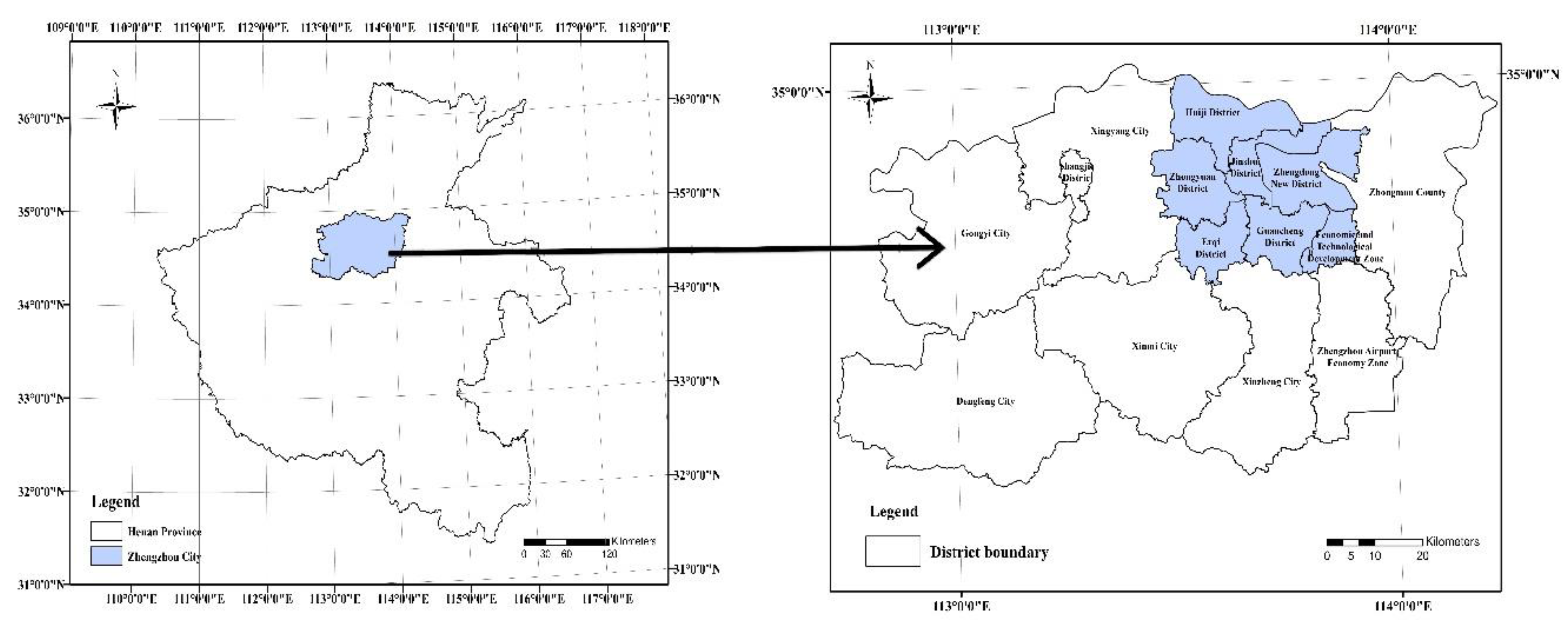
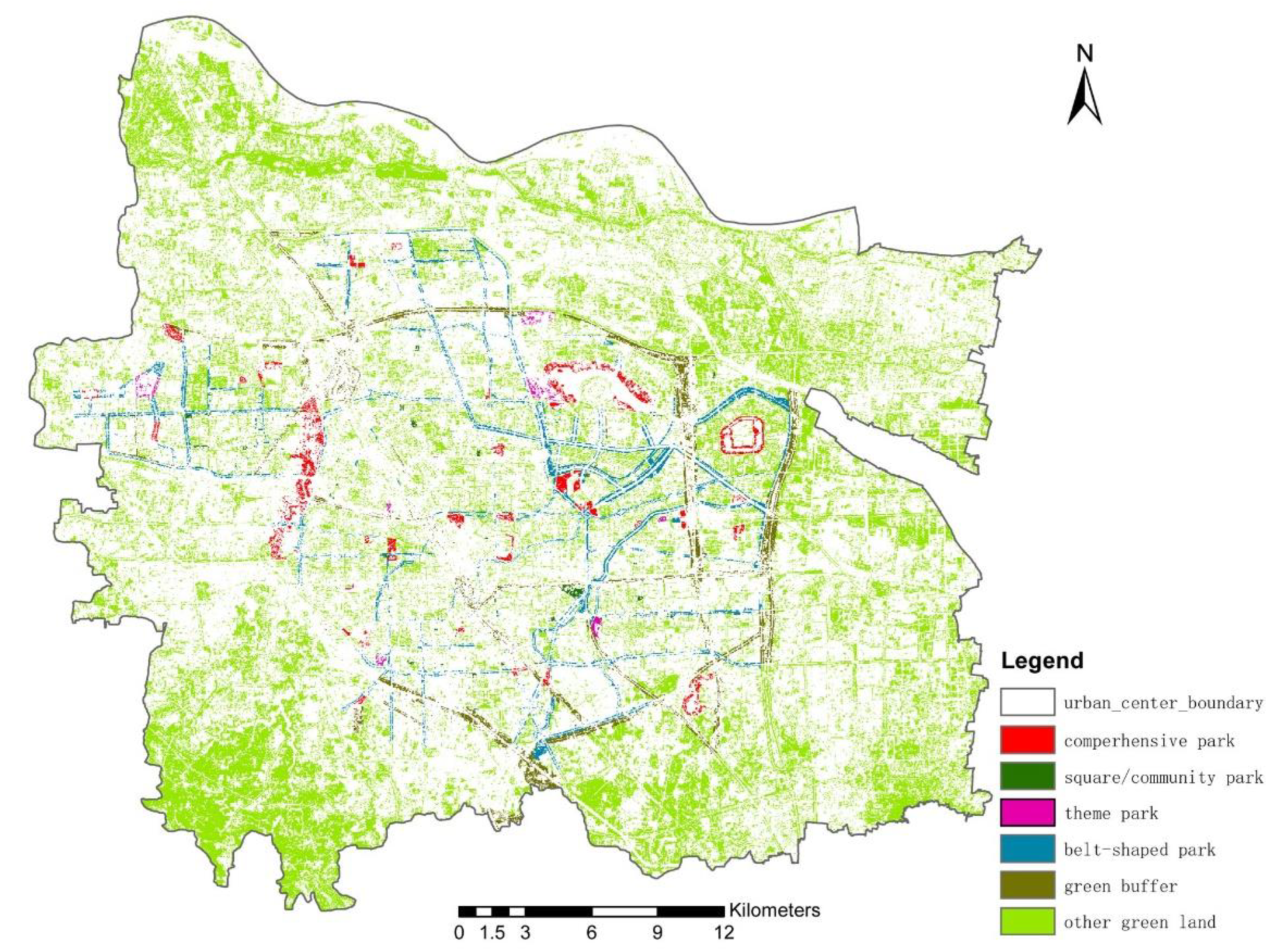
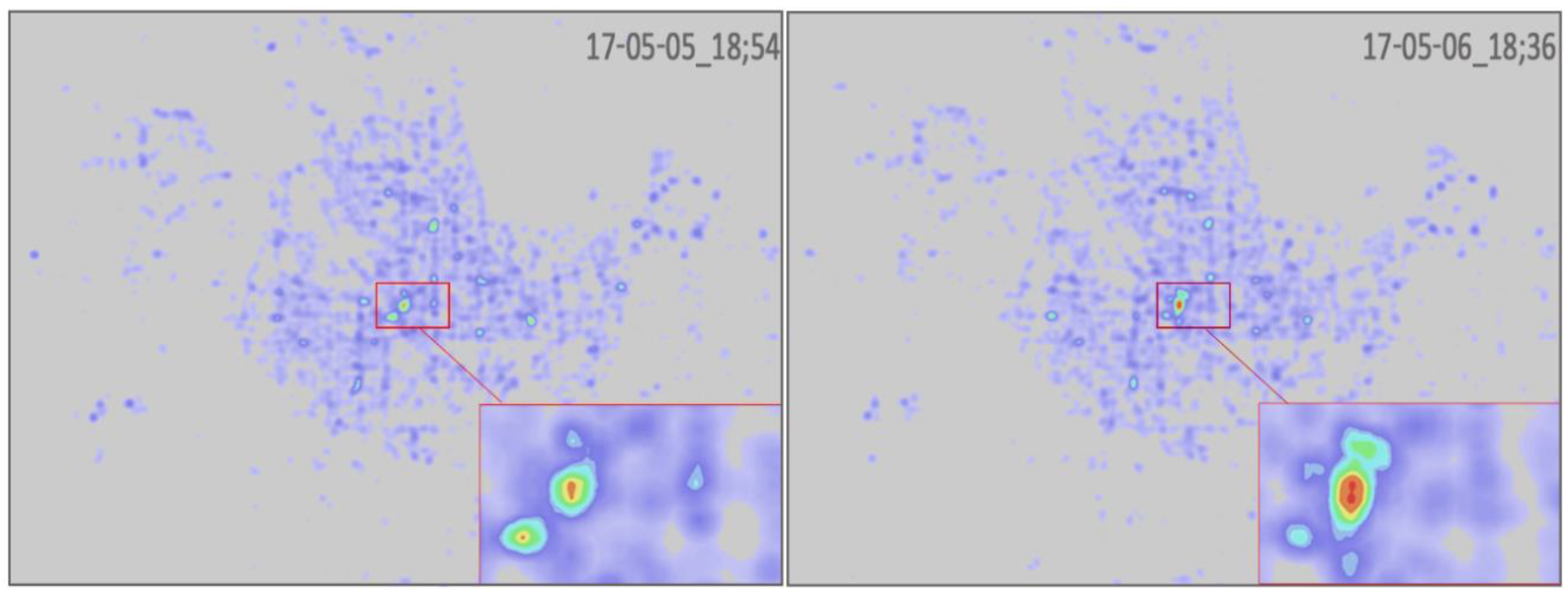

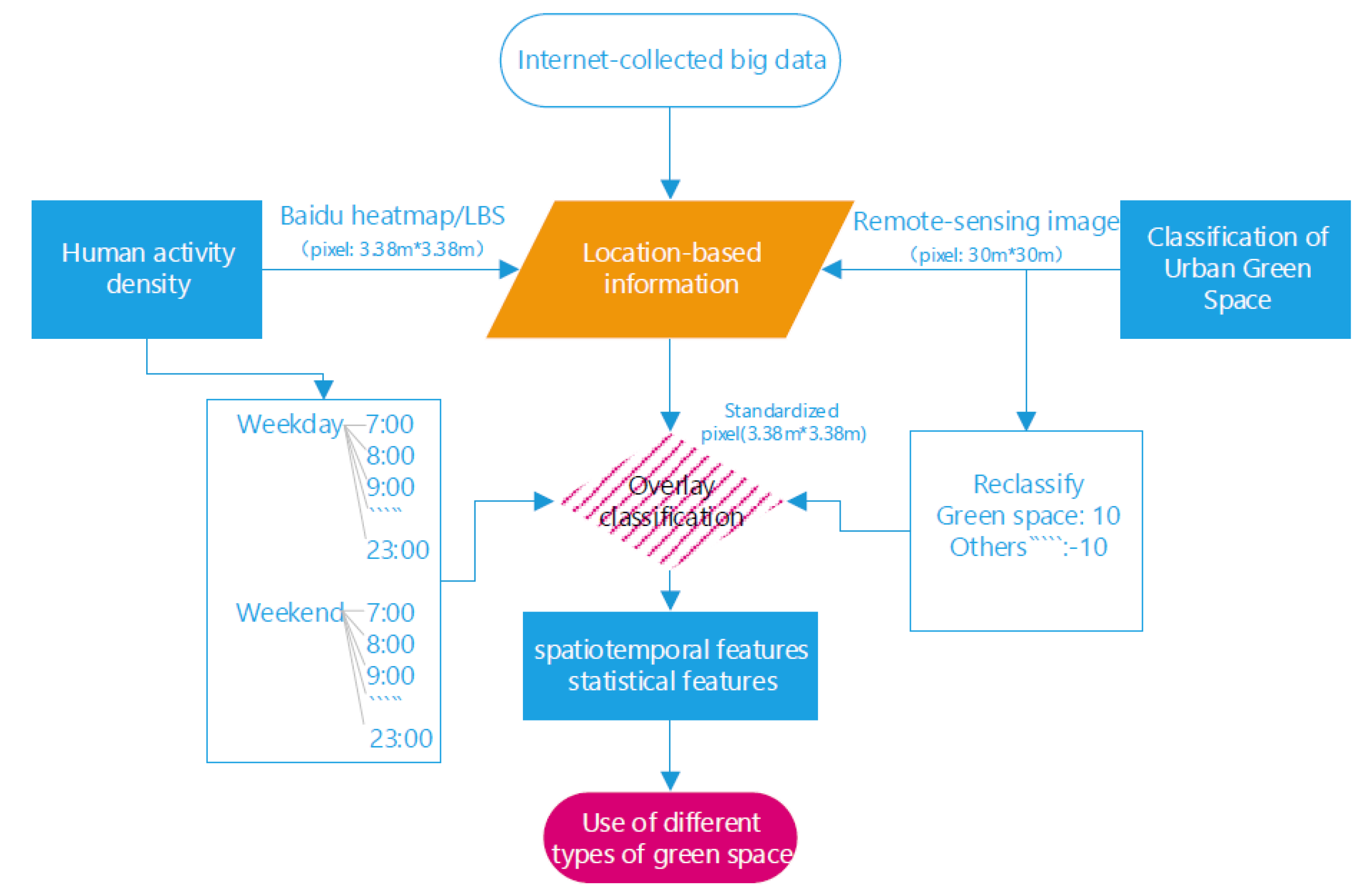

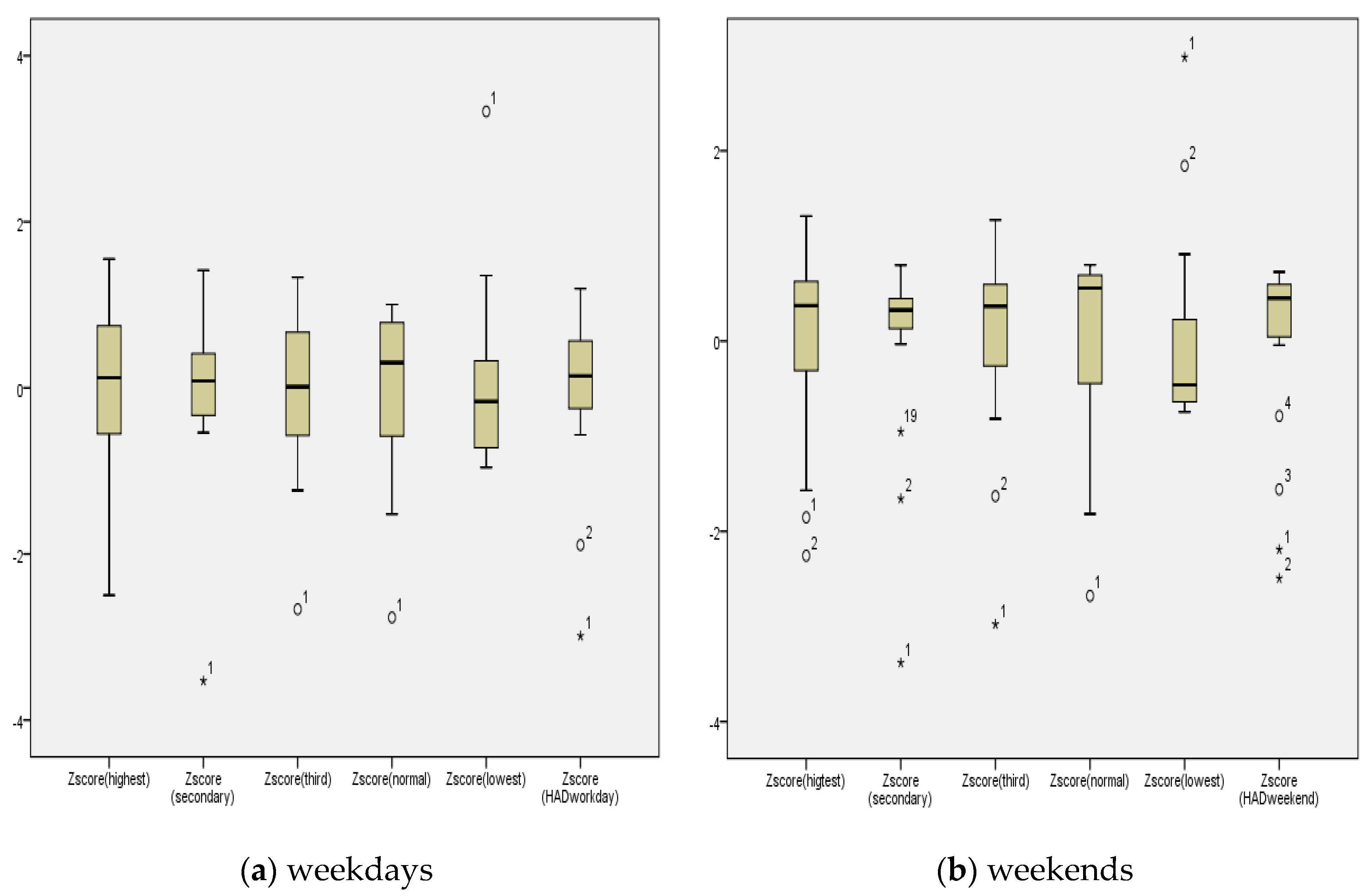
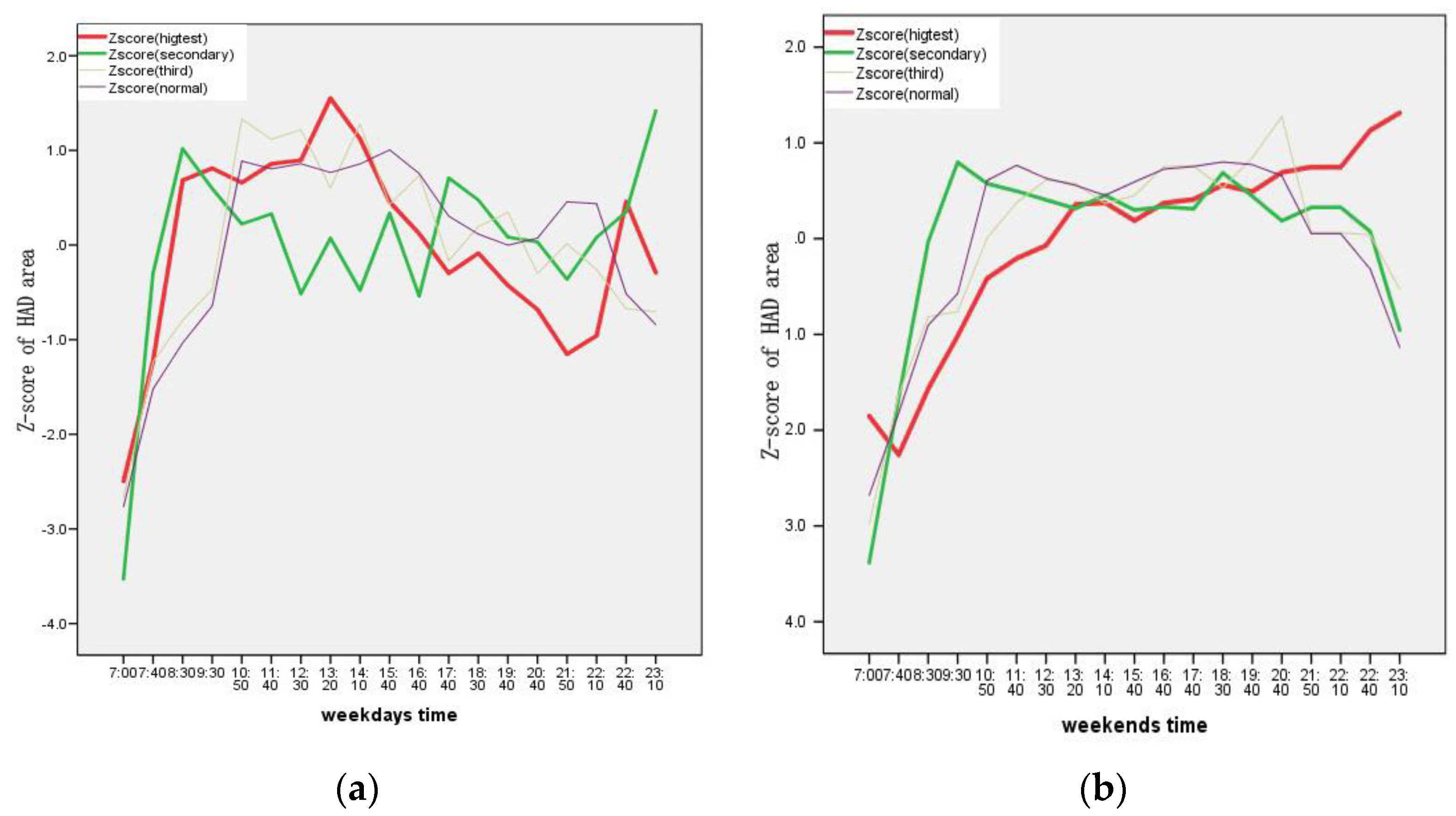




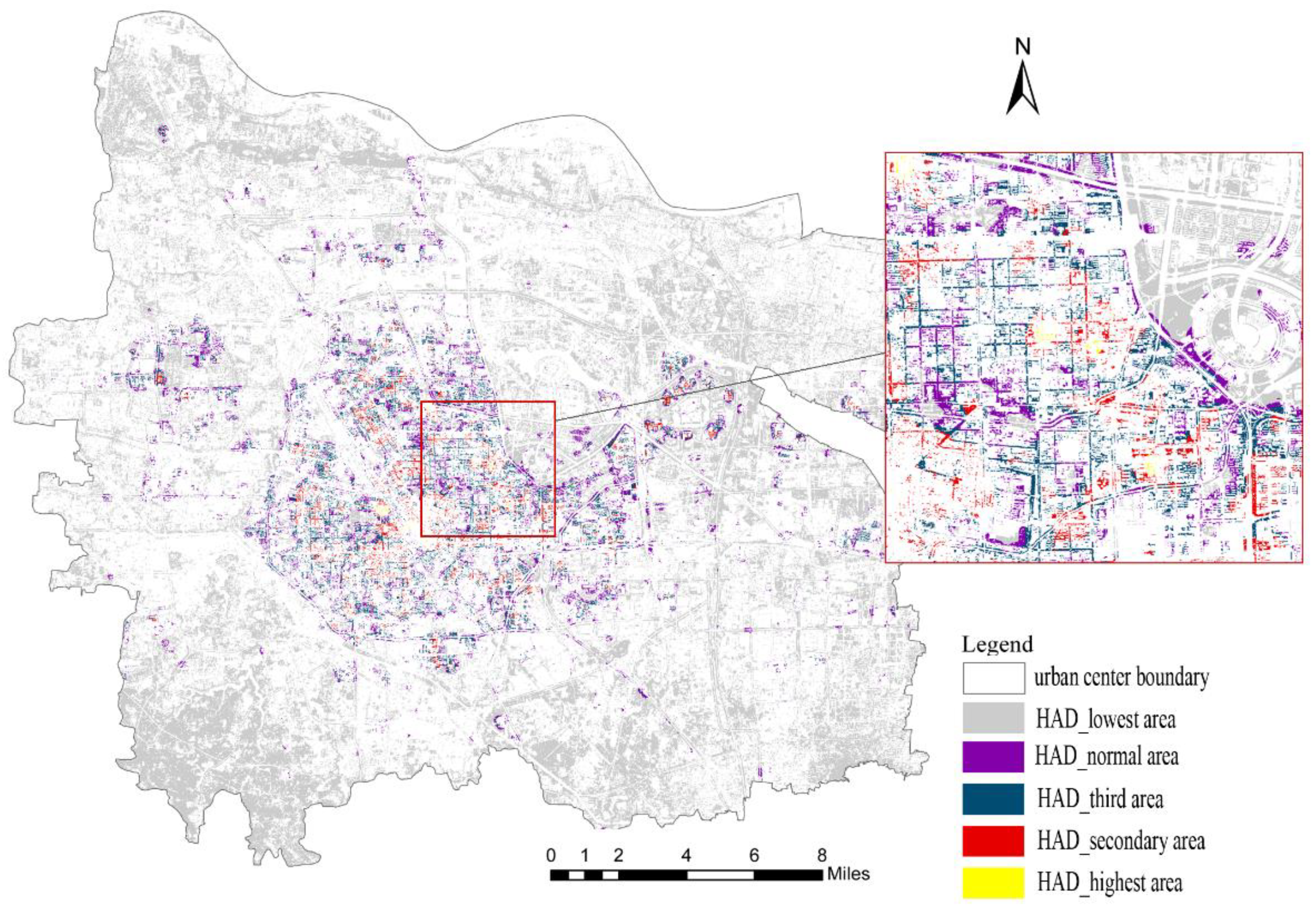
| Green Space Category | Area (km2) |
|---|---|
| None | 901.83 |
| Comprehensive park | 7.70 |
| Square/community park | 0.97 |
| Theme park | 1.09 |
| Belt-shaped park | 18.16 |
| Green buffer | 14.85 |
| Other green space | 273.44 |
| Category | Area (km2) | Percent of Utilization | Proportion of Total Green Space |
|---|---|---|---|
| Square/community park | 0.97 | 63.6% | 0.31% |
| Belt-shaped park | 18.16 | 43.6% | 5.74% |
| Comprehensive park | 7.70 | 36.4% | 2.43% |
| Theme park | 1.09 | 19.3% | 0.35% |
| Green buffer | 14.85 | 14.8% | 4.70% |
| Other green land | 273.44 | 10.5% | 86.48% |
© 2020 by the authors. Licensee MDPI, Basel, Switzerland. This article is an open access article distributed under the terms and conditions of the Creative Commons Attribution (CC BY) license (http://creativecommons.org/licenses/by/4.0/).
Share and Cite
Zhang, S.; Zhang, W.; Wang, Y.; Zhao, X.; Song, P.; Tian, G.; Mayer, A.L. Comparing Human Activity Density and Green Space Supply Using the Baidu Heat Map in Zhengzhou, China. Sustainability 2020, 12, 7075. https://doi.org/10.3390/su12177075
Zhang S, Zhang W, Wang Y, Zhao X, Song P, Tian G, Mayer AL. Comparing Human Activity Density and Green Space Supply Using the Baidu Heat Map in Zhengzhou, China. Sustainability. 2020; 12(17):7075. https://doi.org/10.3390/su12177075
Chicago/Turabian StyleZhang, Shumei, Wenshi Zhang, Ying Wang, Xiaoyu Zhao, Peihao Song, Guohang Tian, and Audrey L. Mayer. 2020. "Comparing Human Activity Density and Green Space Supply Using the Baidu Heat Map in Zhengzhou, China" Sustainability 12, no. 17: 7075. https://doi.org/10.3390/su12177075
APA StyleZhang, S., Zhang, W., Wang, Y., Zhao, X., Song, P., Tian, G., & Mayer, A. L. (2020). Comparing Human Activity Density and Green Space Supply Using the Baidu Heat Map in Zhengzhou, China. Sustainability, 12(17), 7075. https://doi.org/10.3390/su12177075








